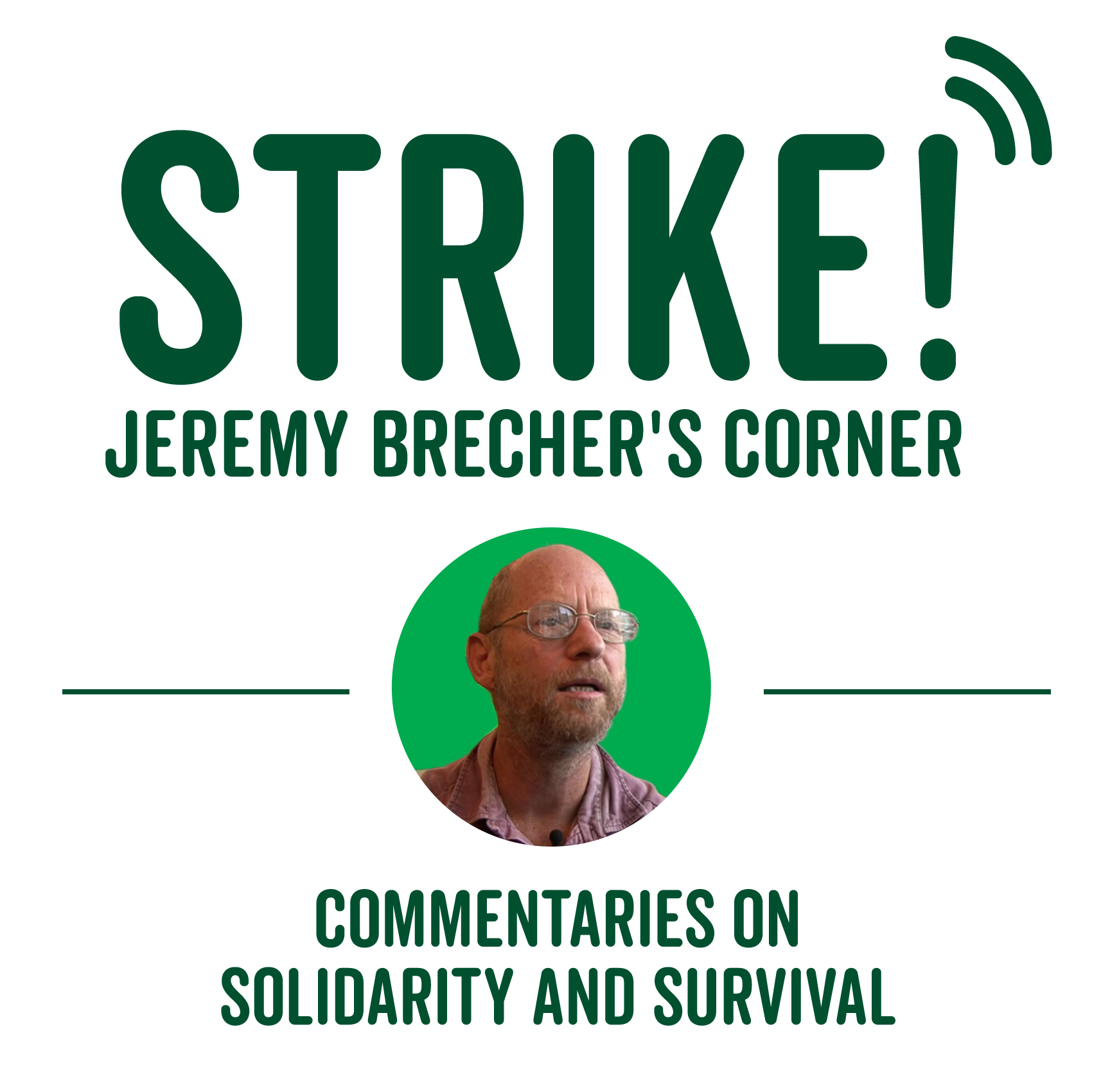Listen to the audio version >>
This is the first of a series of Strike! Commentaries on the “Polycrisis and the Global Green New Deal.” The term “polycrisis” is increasingly being used to describe an era in which multiple crises collide – in particular, our present era. The first set of Commentaries in this series examine geopolitics and war in the era of polycrisis. The next Commentaries look at what is happening after economic globalization. The third set examine political crisis: the degradation of democracy and the rise of fascism. The fourth section lays out the interaction of the climate crisis with the other elements of the polycrisis. Moving to “what is to be done?” the fifth section proposes a “global green new deal” as the key to unlock the polycrisis. The final section proposes a global nonviolent constitutional insurgency backing a “coalition of the willing” as the means to transcend the polycrisis and realize a global green new deal.

Back around 1980 I discovered globalization. I was doing a participatory study of the brass workers in western Connecticut. Meanwhile the brass plants were closing one by one. Companies were demanding that workers take wage cuts and give up union protections. Brass workers tried to explain to us what was going on. Finally, one of them told us, look, they closed my plant and moved the work to Saudi Arabia. That’s what all these companies are doing.
He put two and two together for me. The plants were closing because of something new and eerie. It had become possible – and profitable – for companies to close their plants and move to places where they could pay workers only a fraction of what they paid their US workers. I had never heard the word globalization – I doubt that it was even in use at that time – but it was explained to me by a worker who was experiencing its consequences – consequences that would be felt by millions and are still echoing today.
I gradually became obsessed with globalization. Although talk of globalization was often dismissed both in the mainstream and in the Left as “globaloney,” in fact it was transforming the whole world. I decided I had to understand what was going on, how it was impacting workers and other ordinary people around the world, and what they could do – and were doing – to deal with it. To that end I wrote three books about globalization.[1]
For the past couple of years I have had that same eerie feeling that “something is happening, but you don’t know what it is.” It involved so many seeming confusing and unconnected phenomena that I didn’t know where to begin in trying to understand it. My “ahah” moment came when I read one of historian Adam Tooze’ first essays introducing the concept of the “polycrisis.” Tooze wrote that a polycrisis is “not just a situation where you face multiple crises” but one where “the whole is even more dangerous than the sum of the parts.”[2] That seemed like a concept that might help organize the confusing and conflicting phenomena I was observing – and experiencing. Polycrisis calls to mind the proclamation of a Sean O’Casey character: “The whole world is in a terrible state o’ chassis.”
This series of Commentaries on “Polycrisis and the Global Green New Deal” is my attempt to start pulling together an understanding of the polycrisis. Like my books on globalization, it is also an attempt to begin thinking through what response people around the world might make to overcome the destruction these forces are wreaking on the earth and its people. A tall order, and one I am confident that I am not adequate to fill. But my purpose is to begin opening up understandings and hypotheses that, collectively, we can improve – and test in action.
Why “Polycrisis”?

A variety of experts and millions of ordinary people have noticed that the world order – the patterns by which we organize our life on earth — is cracking up. A forty-year period in which, despite conflict and disorder, war was attenuated and power centers to some extent cooperated, has been replaced by burgeoning conflict, shifting alliances, breakdown of cooperation, and open warfare. There is a growing discussion around the perception that the world order has entered a new phase.
Why?
- Countries around the world are picking up sides – and trying to compel other countries to pick up sides — in geopolitical struggle and multiple wars that look a whole lot like preparation for World War III.
- Despite purported global cooperation to protect the climate, climate-destroying fossil fuel burning is continuing to increase with the complicity of most of the world’s governments, businesses, and other major institutions.
- The evolution toward a globalizing economy has been replaced by economic nationalism, efforts to form trade blocs, trade wars, and a breakdown of international macroeconomic cooperation.
- Democratic governance, already limited, is being further constricted by growing concentrations of private power that render public institutions powerless; electoral manipulation that excludes or marginalizes substantial parts of electorates; and the rise of anti-democratic, authoritarian, nationalist, and xenophobic political movements, parties, and leaders.
- Essential relations between humanity and the rest of nature are increasingly disrupted both by local environmental destruction and by the failure of international cooperation in response to threats to human wellbeing – exemplified dramatically in the nationalist and irrationalist responses to the COVID pandemic.
While the various sectors of the world order, such as economic, political, military, environmental, and energy, have always faced periodic crises, they have most often been crises in one or another sector, even though they have often had some impacts on other sectors. The current global situation is marked not only by crisis in nearly all sectors at the same time, but also by a dynamic in which the crisis in each sphere tends to aggravate the others — with little cooperation among the major power centers to contain let alone ameliorate them. While it is difficult to define a precise date for the emergence of the polycrisis, the Great Recession of 2007-8, the rising challenges to US unipolar global hegemony, and the fragmentation of the global economy combine to form a marker for the start of a new era.
What does this interaction of crises look like? Consider the Ukraine war and the escalating conflict between NATO and Russia. They not only threaten nuclear holocaust; they are causing a global food crisis, a financial crisis, trade wars, strengthening of authoritarian political movements, and an expansion of climate-destroying fossil fuel burning. The climate crisis, in turn, is generating mass migration, destruction of local environments, beggar-your-neighbor competition between China, the US, and Europe over trade in climate-protecting production, and local environmental destruction that is making significant parts of the earth unfit for human habitation.
An obvious and appropriate question is whether today’s polycrisis is different from past “general crises”? Elements of the world order are always in crisis: Local and world wars, local and global economic crises, revolutions, civil wars, dictatorships, and local environmental catastrophes are no anomalies.
While these elements were always intertwined, institutional barriers in the world order normally siloed their crises. For example, until recently both China and US had policies of not using their economic power to achieve victory in geopolitical conflict with each other. China did not use its holdings of US debt in conflicts over issues like the future of Taiwan. The US did little to restrict the transfer of technologies to China that it is now banning on geopolitical grounds.
In times of general crisis, however, the buffers between world order “silos” tend to break down and once-segmented sectors interact in ways that amplify the crisis in each. The Napoleonic Wars, World War I, and World War II provide examples. These general crises often take the form of geopolitical conflict – and war — overriding all else.
Why do these changing dynamics of the world order – its plunge into polycrisis — matter? Polycrisis is a heuristic concept that directs our attention to interactions among crises in different spheres that we might ignore or consider irrelevant if we did not acknowledge that crises in one sphere now interact with those in other spheres and that those interactions in turn have effects in additional spheres as well. Consider climate protection. The collapse of global climate protection efforts at the 2009 Copenhagen Summit was in considerable part a result of the Great Recession which led countries to resist climate protection spending in the name of economic recovery. And global climate protection efforts were sharply curtailed after the outbreak of the Ukraine war.
The stakes are high. A conflicted world order has become a global disorder – approaching a war of all against all that threatens not only humanity but the entire biosphere. Last January the “Doomsday Clock” which each year evaluates threats to human survival was set at 90 seconds to midnight, the closest ever to annihilation. The reasons: “Russia’s invasion of Ukraine and the increased risk of nuclear escalation,” “continuing threats posed by the climate crisis,” and “the breakdown of global norms and institutions needed to mitigate risks associated with advancing technologies and biological threats such as COVID-19.” This January the Doomsday Clock was once again set at 90 seconds to midnight “because humanity continues to face an unprecedented level of danger.”[3]
In this series of Commentaries on “The Polycrisis and the Global Green New Deal” I will try to go beyond describing the polycrisis to explore questions about its significance and how to respond to it. What does polycrisis mean for social movements? What does polycrisis mean for anyone who wants to forestall the nightmare outcomes it seems likely to produce? How can we counter the polycrisis?
This series will examine the polycrisis not just in itself, but also in terms of possibilities for action to transcend it. It will argue that the program of the Green New Deal – at a local, national, and global level – represents the best hope for turning the polycrisis into a livable, sustainable world order. And it will explore how to build an intersectional global movement that can start to reverse the thrust toward doom.
[1] Jeremy Brecher, Jill Cutler, and Jeremy Brecher, eds., Global Visions: Beyond the New World Order. (Boston: South End Press, 1994); Jeremy Brecher and Tim Costello. Global Village or Global Pillage. (Boston: South End Press, 1998); Jeremy Brecher, Tim Costello, and Brendan Smith. Globalization from Below: The Power of Solidarity. (Cambridge, Mass.: South End Press, 2002).
[2] Adam Tooze. “Chartbook #131 Calibrating the Polycrisis – with the Help of the Bank of International Settlements.” Chartbook. June 26, 2022. https://adamtooze.substack.com/p/chartbook-131-calibrating-the-polycrisis.
[3] John Mecklin. “A Time of Unprecedented Danger: It Is 90 Seconds to Midnight.” Bulletin of the Atomic Scientists. January 23, 2024. https://thebulletin.org/doomsday-clock/current-time/.

